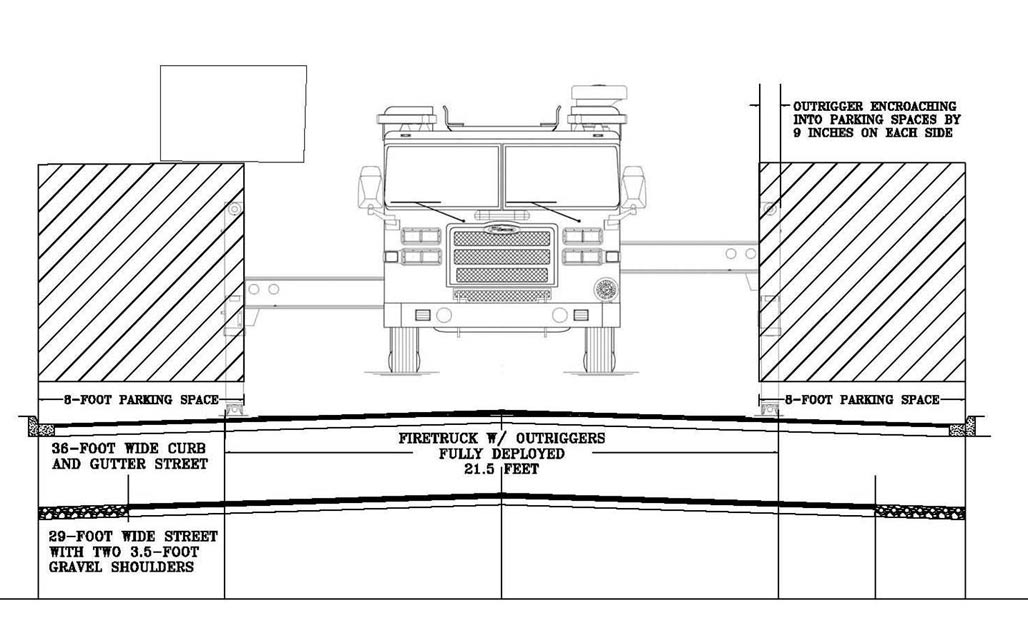
Municipalities have cook books for those interested in adding to City infrastructure. How to make a ramp, how to build a curb, how to make a fire engine cozy.

Some Cities include in the cook books specifications for green infrastructure. How to plant a tree in an urban environment and obtain its ecosystem services, how to build a road that won’t hurt the river, how to infiltrate rainwater into the ground near where it falls.
Search your City’s standards manual for the words green, narrow, sustainable, pervious, woonerf…
One thought on “standards and design-fire engines”
Comments are closed.
5. Is the Fire Department currently, or have they previously, looked into the
purchase of trucks that could possibly be more compatible with conditions
created by a higher density urban designed city environment, such as narrower
streets and/or taller buildings? Please explain the Fire department’s logic of
which apparatus to purchase – showing why a larger piece of equipment may, or
may not, be more appropriate.
Yes we have, from the standpoint of continuously looking to see what’s currently
available. However, the size of the trucks are dictated more by the equipment that
we’re required to carry by national standards (National Fire Protection Association –
N.F.P.A.), what we’ve found we need to carry based on local needs, and Federal
regulation. Some examples are water tank size (we carry 500 gallons of water,
adequate for only about 2 ½ minutes of firefighting), an assortment of ladders, and an
assortment of hose sizes (including 1000’ of 4” supply hose). Fuel spills require the
use of absorbents (and additional storage space to carry them), as opposed to flushing
them down drains. A recently completed Insurance Services Organization (I.S.O.)
review required us to provide inventories of all Fire Department pumpers and ladder
trucks to insure that they met N.F.P.A. standards – I.S.O. reviews are used to
establish fire insurance rates for the community.
Safety and environmental standards, to a certain extent, have affected sizes over the
years – all personnel are required to be seated and belted and must be in fully
enclosed cabs, instead of standing on the back steps and sides or riding in open cabs
like we did up until the 1980’s. Over the past 5 years, E.P.A. standards for diesel
engines have caused most manufacturers to widen cabs of fire apparatus out to 100”.
The trucks we use (both engines and ladder trucks) are the same as those used in the
urban environments of all U.S. cities (Boston, for example, has sections known for its
narrow streets). European apparatus, on the other hand, may be smaller but do not
meet U.S. standards and can’t carry the same amounts of equipment.
The Department’s most recently ordered apparatus do have shorter wheelbases, which
improves the turning radius. One additional note, in order to go to smaller
apparatus we would have to add additional resources, including specialized apparatus
and hiring more personnel in order to get an effective firefighting force on the scene
of a fire or other emergency. Neither of which, as the Fire Department can see, are
changes supported by current City budget trends. It is also important to understand
that street widths are regulated by code, not by the size of the fire apparatus,
providing space for other vehicles to yield the right-of–way as well as providing
needed space for operational issues like hose deployment, tool and equipment access,
aerial ladder outrigger placement and safe operating areas for firefighters. Any
2
further reduction in street widths and apparatus access will have an adverse impact on
the Department’s lifesaving and firefighting effectiveness resulting in greater loss of
life and property damage.